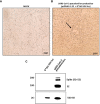Long-lasting neutralizing antibodies and T cell response after the third dose of mRNA anti-SARS-CoV-2 vaccine in multiple sclerosis
- PMID: 37409134
- PMCID: PMC10318111
- DOI: 10.3389/fimmu.2023.1205879
Long-lasting neutralizing antibodies and T cell response after the third dose of mRNA anti-SARS-CoV-2 vaccine in multiple sclerosis
Abstract
Background and objectives: Long lasting immune response to anti-SARS-CoV-2 vaccination in people with Multiple Sclerosis (pwMS) is still largely unexplored. Our study aimed at evaluating the persistence of the elicited amount of neutralizing antibodies (Ab), their activity and T cell response after three doses of anti-SARS-CoV-2 vaccine in pwMS.
Methods: We performed a prospective observational study in pwMS undergoing SARS-CoV-2 mRNA vaccinations. Anti-Region Binding Domain (anti-RBD) of the spike (S) protein immunoglobulin G (IgG) titers were measured by ELISA. The neutralization efficacy of collected sera was measured by SARS-CoV-2 pseudovirion-based neutralization assay. The frequency of Spike-specific IFNγ-producing CD4+ and CD8+ T cells was measured by stimulating Peripheral Blood Mononuclear Cells (PBMCs) with a pool of peptides covering the complete protein coding sequence of the SARS-CoV-2 S.
Results: Blood samples from 70 pwMS (11 untreated pwMS, 11 under dimethyl fumarate, 9 under interferon-γ, 6 under alemtuzumab, 8 under cladribine, 12 under fingolimod and 13 under ocrelizumab) and 24 healthy donors were collected before and up to six months after three vaccine doses. Overall, anti-SARS-CoV-2 mRNA vaccine elicited comparable levels of anti-RBD IgGs, neutralizing activity and anti-S T cell response both in untreated, treated pwMS and HD that last six months after vaccination. An exception was represented by ocrelizumab-treated pwMS that showed reduced levels of IgGs (p<0.0001) and a neutralizing activity under the limit of detection (p<0.001) compared to untreated pwMS. Considering the occurrence of a SARS-CoV-2 infection after vaccination, the Ab neutralizing efficacy (p=0.04), as well as CD4+ (p=0.016) and CD8+ (p=0.04) S-specific T cells, increased in treated COVID+ pwMS compared to uninfected treated pwMS at 6 months after vaccination.
Discussion: Our follow-up provides a detailed evaluation of Ab, especially in terms of neutralizing activity, and T cell responses after anti-SARS-CoV-2 vaccination in MS context, over time, considering a wide number of therapies, and eventually breakthrough infection. Altogether, our observations highlight the vaccine response data to current protocols in pwMS and underline the necessity to carefully follow-up anti-CD20- treated patients for higher risk of breakthrough infections. Our study may provide useful information to refine future vaccination strategies in pwMS.
Keywords: COVID-19; T-cell response; anti-SARS-CoV-2 vaccination; disease modifying therapies; multiple sclerosis; neutralizing antibodies.
Copyright © 2023 Maglione, Francese, Arduino, Rosso, Matta, Rolla, Lembo and Clerico.
Conflict of interest statement
MM received personal compensations for advisory boards and travel grants from Novartis, Sanofi-Genzyme; SR received personal compensations for public speaking and travel grants from Sanofi-Genzyme and Merck Serono; MC received personal compensations for advisory boards, public speaking, editorial commitments or travel grants from Biogen Idec, Merck Serono, Fondazione Serono, Novartis, Pomona, Sanofi-Genzyme and Teva. The remaining authors declare that the research was conducted in the absence of any commercial or financial relationships that could be construed as a potential conflict of interest.
Figures





Similar articles
-
Humoral and Cellular Immune Responses to SARS-CoV-2 mRNA Vaccination in Patients with Multiple Sclerosis: An Israeli Multi-Center Experience Following 3 Vaccine Doses.Front Immunol. 2022 Apr 1;13:868915. doi: 10.3389/fimmu.2022.868915. eCollection 2022. Front Immunol. 2022. PMID: 35432335 Free PMC article.
-
Six-month humoral response to mRNA SARS-CoV-2 vaccination in patients with multiple sclerosis treated with ocrelizumab and fingolimod.Mult Scler Relat Disord. 2022 Apr;60:103724. doi: 10.1016/j.msard.2022.103724. Epub 2022 Mar 4. Mult Scler Relat Disord. 2022. PMID: 35272145 Free PMC article.
-
B- and T-Cell Responses After SARS-CoV-2 Vaccination in Patients With Multiple Sclerosis Receiving Disease Modifying Therapies: Immunological Patterns and Clinical Implications.Front Immunol. 2022 Jan 17;12:796482. doi: 10.3389/fimmu.2021.796482. eCollection 2021. Front Immunol. 2022. PMID: 35111162 Free PMC article. Clinical Trial.
-
COVID-19: The Course, Vaccination and Immune Response in People with Multiple Sclerosis: Systematic Review.Int J Mol Sci. 2023 May 25;24(11):9231. doi: 10.3390/ijms24119231. Int J Mol Sci. 2023. PMID: 37298185 Free PMC article.
-
COVID-19 in patients with multiple sclerosis-A narrative review.Mult Scler Relat Disord. 2025 Jan;93:106221. doi: 10.1016/j.msard.2024.106221. Epub 2024 Dec 8. Mult Scler Relat Disord. 2025. PMID: 39675123 Review.
Cited by
-
Humoral and Cellular Immunity After Vaccination Against SARS-CoV-2 in Relapsing-Remitting Multiple Sclerosis Patients Treated with Interferon Beta and Dimethyl Fumarate.Biomedicines. 2025 Jan 9;13(1):153. doi: 10.3390/biomedicines13010153. Biomedicines. 2025. PMID: 39857737 Free PMC article.
-
Longitudinal study of immunity to SARS-CoV2 in ocrelizumab-treated MS patients up to 2 years after COVID-19 vaccination.Ann Clin Transl Neurol. 2024 Jul;11(7):1750-1764. doi: 10.1002/acn3.52081. Epub 2024 May 7. Ann Clin Transl Neurol. 2024. PMID: 38713096 Free PMC article.
-
Extensive T-Cell Profiling Following SARS-CoV-2 mRNA Vaccination in Multiple Sclerosis Patients Treated with DMTs.Pathogens. 2025 Feb 27;14(3):235. doi: 10.3390/pathogens14030235. Pathogens. 2025. PMID: 40137720 Free PMC article.
References
Publication types
MeSH terms
Substances
LinkOut - more resources
Full Text Sources
Medical
Research Materials
Miscellaneous

